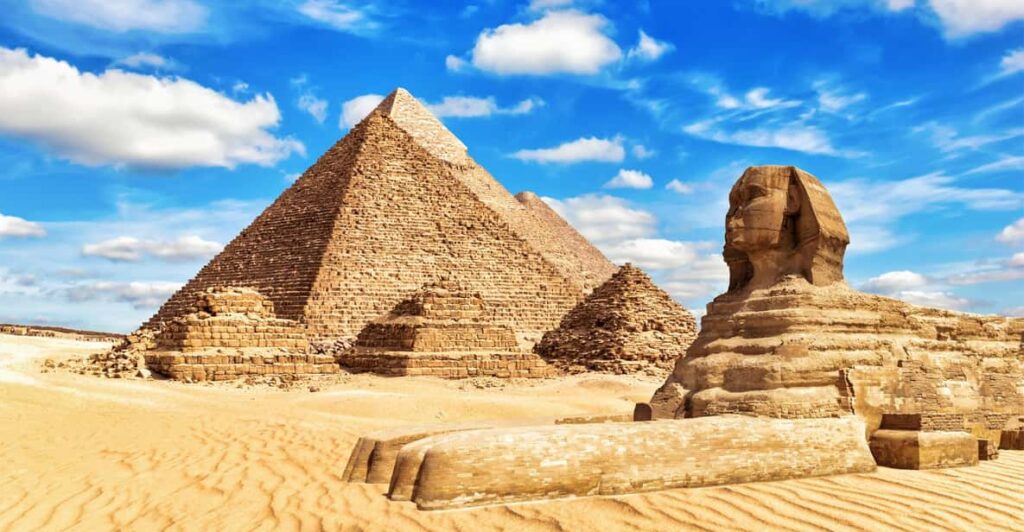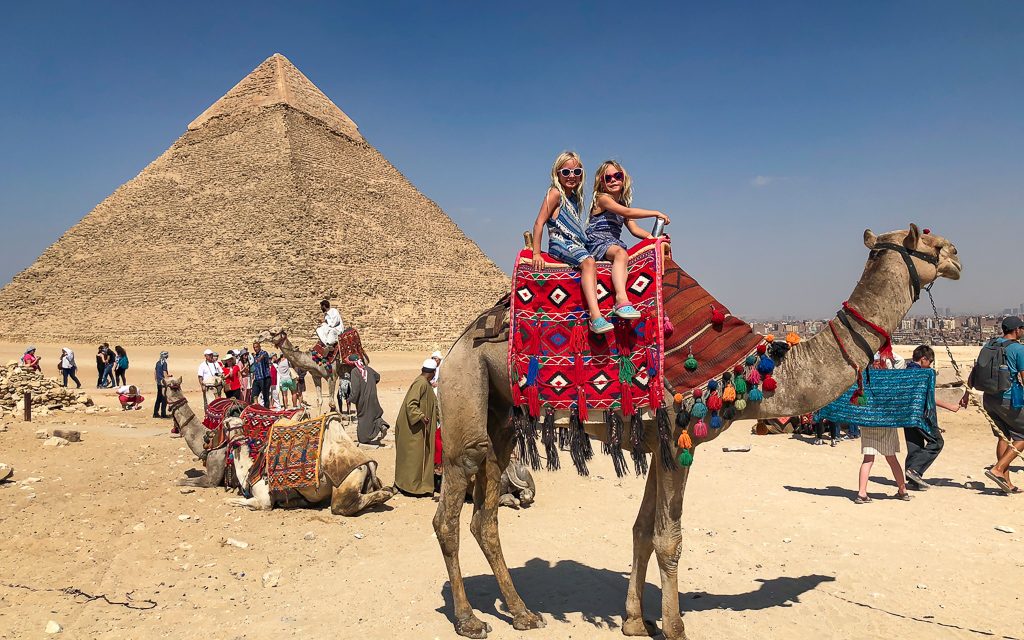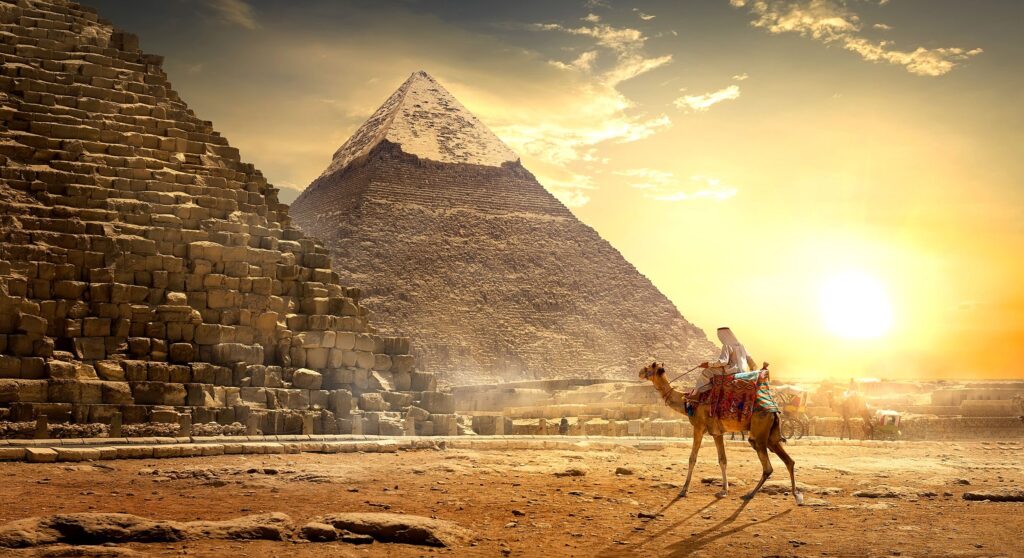
the Pyramids
- Stepping Back in Time: The Story of Giza
- Beyond the Pyramids: Discovering the Giza Necropolis
- Visiting the Giza Pyramids: Everything You Need to Know
🏜️ Welcome to the Timeless Majesty of Giza
Welcome to Giza—the beating heart of ancient Egypt—where the timeless silhouettes of the pyramids rise from the golden desert. Towering over the sands, these monumental structures are enduring symbols of the ancient Egyptians’ brilliance and ambition. With Luna Travelers, you’re invited to travel through time, uncovering the wonders and hidden stories of one of the world’s most awe-inspiring archaeological sites.

🏛️ Stepping Back in Time: The Story of Giza
The Giza Pyramids, part of the iconic Giza Necropolis, are a UNESCO World Heritage Site and the last surviving Wonder of the Ancient World. Built during Egypt’s Fourth Dynasty (2686–2181 BC), they served as monumental tombs for Pharaohs Khufu, Khafre, and Menkaure, alongside their queens.
🔺 The Great Pyramid of Khufu
The largest and most famous of the trio, the Great Pyramid of Khufu, is a marvel of engineering that continues to puzzle and inspire.
- A Monumental Feat: Standing originally at 146.5 meters (481 feet), it consists of over 2 million limestone blocks, each weighing about 2.5 tons. The techniques used to construct it are still debated by scholars today.
- Inside the Pyramid: Visitors can navigate narrow corridors to explore chambers like the King’s Chamber and Queen’s Chamber, adding layers of mystery to this ancient tomb.
- Stunning Views: From the base or nearby vantage points, you can soak in sweeping views of the Giza Plateau and the surrounding desert landscape.

🧱 The Pyramid of Khafre & the Sphinx
Located adjacent to Khufu’s pyramid, the Pyramid of Khafre is slightly smaller but appears taller due to its elevated location and intact casing stones.
- Eternal Home of Khafre: This structure was designed as the final resting place for Khufu’s son, Pharaoh Khafre, and features a grand mortuary temple and ceremonial causeway.
- The Great Sphinx of Giza: Guarding Khafre’s pyramid, the Sphinx—with a lion’s body and a human face—stands as one of Egypt’s most iconic and enigmatic monuments.
🧱 The Pyramid of Menkaure
The smallest of the three, this pyramid was built for Pharaoh Menkaure, yet still reflects meticulous craftsmanship and reverence.
- Built with Precision: Constructed from limestone and granite, the pyramid showcases the refined skill of the ancient builders.
- Mortuary Temple: Adjacent ruins display beautifully preserved reliefs that offer insight into ancient Egyptian rituals and artistry.
🏺 Beyond the Pyramids: Discovering the Giza Necropolis
Giza isn’t just about the pyramids—it’s a vast archaeological landscape rich in history and insight into everyday ancient life.
- Sphinx Temple: Located beside the Great Sphinx, this temple once served as a sacred space of worship and processional route.
- Valley Temple of Khafre: Positioned at the base of the Giza Plateau, this temple was likely used in the mummification process. Its architecture reveals the ceremonial significance of burial traditions.
- Workers’ Village: Recent excavations have uncovered the remains of the laborers who built the pyramids—highlighting their organized lifestyle, nutritious diets, and the scale of manpower involved.
- Mastaba Tombs: These flat-roofed rectangular tombs housed the remains of nobles and officials, offering a deeper understanding of Egypt’s ancient society.
- Solar Boat Museum: This modern museum displays a remarkably preserved cedarwood boat believed to have carried Khufu’s spirit into the afterlife.
📍 Visiting the Giza Pyramids: Everything You Need to Know
🗓️ Planning Your Trip
- When to Visit: Aim for October–November or March–April for mild temperatures and manageable crowds. Summer (June–August) can be very hot and less ideal for touring.
- How Much Time to Spend: Set aside at least one full day to explore the pyramids and surrounding landmarks thoroughly
🏛️ Entering the Pyramids
- Ticket Info: Entrance fees vary by site. Combo tickets for multiple attractions (including the pyramids and Sphinx) are cost-effective.
- Photography: Allowed in most areas. Be mindful of signs and staff instructions regarding restrictions, especially in interior chambers.
🎒 Tips for a Smooth Visit
- Footwear: Wear comfortable, sturdy shoes—you’ll be doing plenty of walking and light climbing.
- Essentials: Carry water, snacks, sunscreen, sunglasses, and a hat to stay comfortable in the desert heat.
- Cultural Respect: Dress modestly and observe local customs, especially when visiting religious or sacred sites.
🕌 Exploring More Around Giza
- Egyptian Museum (Cairo): Home to an immense collection of ancient artifacts, including Tutankhamun’s treasures.
- Old Cairo: Walk through centuries of history in the Coptic, Islamic, and Jewish quarters of Egypt’s capital.
- Shopping & Souvenirs: From bustling bazaars to modern malls, Cairo is a shopper’s paradise.

🧩 Frequently Asked Questions
1. Did the Egyptians use advanced technology to build the pyramids?
There’s no evidence that ancient Egyptians used anything beyond simple tools, mathematics, and skilled labor. While their achievements were remarkable, the theories involving aliens or futuristic tech are unfounded.
2. Are there still undiscovered secrets inside the pyramids?
Many believe there are hidden chambers and unknown corridors within the pyramids. Advanced scanning continues to fuel curiosity, but much remains speculative.
3. Why are the pyramids aligned with the stars?
The pyramids’ precise alignment with celestial bodies suggests deep astronomical knowledge. Some experts believe this alignment had religious significance, linking the pharaohs with the stars and gods.
✨ Final Thoughts
The Giza Pyramids are more than just ancient wonders—they are windows into one of humanity’s most extraordinary civilizations. Through Luna Travelers, you can immerse yourself in the legends, architecture, and spiritual depth that define this sacred site. Let the sands of Giza guide your steps, and take home not just memories, but a deeper appreciation for the ancient world.
